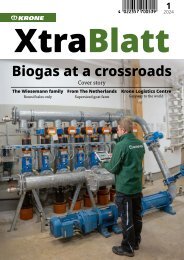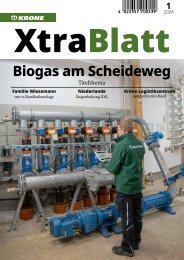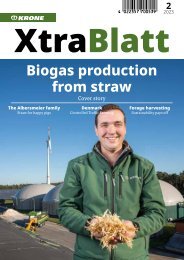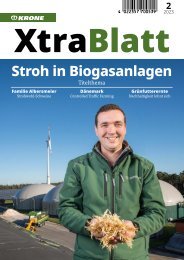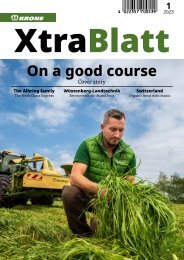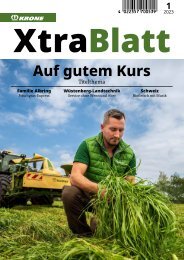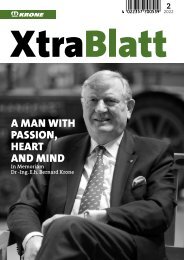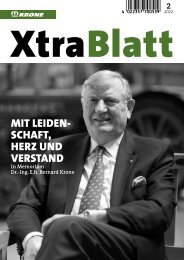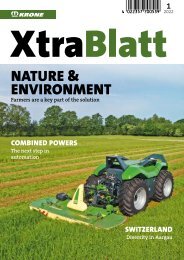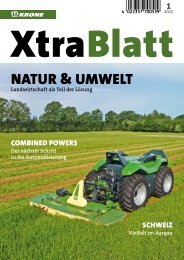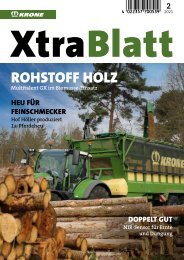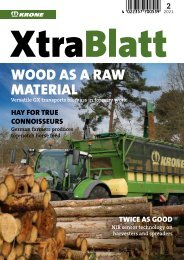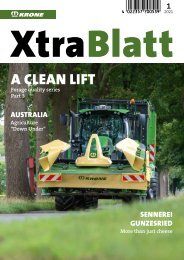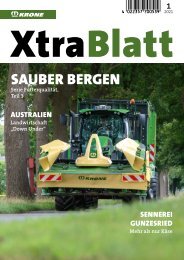XtraBlatt Issue 02-2020
You also want an ePaper? Increase the reach of your titles
YUMPU automatically turns print PDFs into web optimized ePapers that Google loves.
ON-FARM<br />
1 2 3<br />
1 Because ideal cutting and curing<br />
windows in the hay season for quality<br />
horse forage are relatively short, the<br />
brothers apply a machinery fleet that<br />
ensures highest harvesting capacity.<br />
2 The main enterprise on Oberberghof<br />
is a horse pension.<br />
3 Hay and straw are almost exclusively<br />
pressed into square bales.<br />
two American miniature ponies and two<br />
Deutsche ponies share the paddocks.”<br />
OWN FORAGE<br />
Alongside a riding hall and another<br />
all-weather riding facility, both of which<br />
feature special textile-mix floor surfaces, the<br />
facilities include a solarium, a horse exercising<br />
system and bad weather paddocks with<br />
sand floors. “Our grandfather also started a<br />
riding school”, recalls Florian Kneer. “Nowadays,<br />
however, we’re purely a horse pension,<br />
although a certified groom on the payroll offers<br />
riding lessons and trains horses. We have<br />
a second employee for feeding, mucking and<br />
carrying out other jobs around the yard.”<br />
While many stud farms buy-in their feed,<br />
the Kneers prefer home-grown forage. “We<br />
harvest hay, haylage and silage, although the<br />
silage is sold off the farm. Straw is bought<br />
in the swath from other farmers. We bale it<br />
ourselves with large square balers also used<br />
for our hay baling. For the haylage and silage,<br />
a round baler with plastic foil binding is put<br />
to work. We’ve had good experiences with<br />
this system.”<br />
One of the two large square balers is a<br />
Krone BiG Pack 1270 VC with multiblade<br />
cutting system. Now, one might think that<br />
such high technology might make more<br />
sense on a dairy farm, and rather less so<br />
with horses. Moritz Kneer argues against<br />
this: “For over 90 % of the straw, we bale<br />
for horse litter with all 51 knives fitted. The<br />
great advantage is that the chopped litter<br />
is more moisture-absorbent and makes for<br />
easier and cleaner mucking-out. On top of<br />
this, the resultant dung is a better fertiliser,<br />
degrading faster in the soil. Initially, we<br />
had our doubts about chopping, the litter<br />
looking less comfortable as bedding to our<br />
customers. But the advantages mean we<br />
have never had negative feedback.”<br />
WORK CAPACITY<br />
WISHED FOR<br />
The mowing machinery mainly hails from<br />
Emsland too. A front-rear combination<br />
without conditioner is used for smaller<br />
parcels. For larger fields, a rear-mounted<br />
butterfly mower from another manufacturer.<br />
“The decision for the Krone F 400 CV<br />
front mower was because of its 4 m working<br />
width. We need that here because, among<br />
other points, it gives an overlapping action<br />
especially useful on side slopes”, explains<br />
Moritz Kneer.<br />
A pulled KW-T 1300 teds hay. The brothers<br />
are very satisfied with this. It’s extremely<br />
manoeuvrable, even in small areas, and still<br />
offers high work capacity – very important<br />
for main forage hay. Quality hay means that,<br />
within the small time-slot,all crop should<br />
be turned, especially important for first cut.<br />
For the same reason, a suitably dimensioned<br />
4-rotor swather, a Swadro 1400<br />
Plus, is also on the inventory. “At first we<br />
had a side-swather, then a central delivery<br />
swather, running both of them for a period”,<br />
recalls Moritz Kneer. “Now all the work is<br />
carried out by a single machine. Optically, it<br />
gives the impression of great size although<br />
in reality it’s just as agile as a two-rotor<br />
side swather and is especially suitable for<br />
collecting grass cleanly out of corners.”<br />
The Krone products, incidentally, all come<br />
from the firm Steinbrenner in Wörnitz,<br />
which also takes care of service and<br />
maintenance. This is despite the workshop<br />
being around two hours’ drive from the<br />
farm. Says Florian Kneer: “We got to know<br />
this dealership because we were contract<br />
harvesting nearby. Especially with more<br />
complicated machinery such as our large<br />
square balers, the team working around<br />
Willy Waldmann and workshop master<br />
Stefan Sarke impressed us so much that<br />
we’ve stayed with them. The work is either<br />
done in the dealership facilities or sometimes<br />
back on our farm.”<br />
THREE CUTS<br />
Hay and straw are harvested from around<br />
450 ha, the large square balers produce<br />
some 6,000 bales per season, the round<br />
baler managing between 3,000 and<br />
3,500 bales. Most of the machinery and<br />
implements at Oberberghof are also used<br />
on other farms. “We’ve always aimed to<br />
have spare machinery capacity”, points out<br />
Florian Kneer. “This is because for feeding<br />
horses we can only use the very best forage.<br />
The same applies to the straw litter. To<br />
enable fast and flexible work we started<br />
in 2005 with our first big machine, a large<br />
square baler. Neighbours then increasingly<br />
asked if we could also bale for them on a<br />
contract basis. This enterprise has steadily<br />
expanded.”<br />
As a rule, three forage cuts are made on<br />
grassland, the first exclusively for hay, the<br />
second, depending on weather and growth,<br />
for öhmd (the local term for aftermath hay)<br />
and/or silage and the third for silage only.<br />
Mainly, the last cut takes place mid-October<br />
with the brothers careful that the sward<br />
doesn’t go into winter too long because<br />
this gives best conditions for field mouse<br />
overwintering. Haying mostly starts in mid-<br />
June. Work peaks can mostly be spaced out<br />
well because the contracting dairy farms<br />
have differing harvest times, although this<br />
year haying proved a non-stop operation for<br />
two entire weeks.<br />
On their own fields, Florian and Moritz<br />
Kneer aim for a high-quality mix of grass<br />
and herbs in their leys. Deliberately, they’ve<br />
stayed clear of stewardship schemes that<br />
lay down limited mowing times because<br />
they like full control of their haying operation.<br />
They’ve had the experience that<br />
some weeds in the sward have multiplied<br />
massively during recent dry years. Their<br />
answer: rolling, tine harrowing and reseeding.<br />
Brought-in for the control of poisonous<br />
pasture weed saffron crocus is a prism roller.<br />
STAYING FLEXIBLE<br />
Part and parcel of horse farming is the<br />
production of solid manure from litter and<br />
its spreading. Used for this is a 24 t, 22 m³<br />
Annaburger spreader. For contracted and<br />
own silage, maize and chopped forage<br />
transport, a Krampe hooklift trailer has<br />
been invested in. When asked about the<br />
rather smaller transport capacity with the<br />
body-swap system, Moritz Kneer explains<br />
that flexibility is more important, with both<br />
skip and flatbed bodies used.<br />
The flatbed platform is also used transporting<br />
construction and landscape-care<br />
machinery including mobile backhoe,<br />
tree-grip attachment, tracked mower and<br />
tractor for steep slopes – all used in the<br />
brothers’ contracting enterprise. “A further<br />
big advantage is that we can use the trailer<br />
at speeds up to 60 km/h (36 mph) on the<br />
road, pulled by an Agrar-Unimog or a Fendt<br />
926. We’ve been driving Unimogs for a very<br />
long time. They’re maybe not optimal for<br />
all farm jobs but we like them a lot: they’re<br />
low-wear with economic fuel consumption<br />
and high road speeds.” The rest of the tractor<br />
fleet comprises mainly Fendt machines,<br />
some of them getting on in years, but all in<br />
top condition.<br />
While it’s true Oberberghof is not the main<br />
enterprise in the Kneer business, it is run<br />
very professionally indeed. And listening to<br />
the brothers’ considerations on purchasing<br />
decisions, their experiences with machinery<br />
and other technical details makes it clear<br />
that both are farmers with great passion<br />
and therefore real professionals, with an<br />
amateur love of the land! «<br />
36 37



